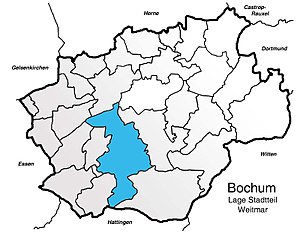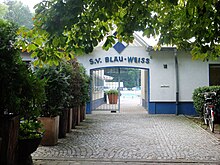Weitmar
|
Weitmar district of Bochum |
|
|---|---|
| Coordinates | 51 ° 27 '8 " N , 7 ° 11' 32" E |
| height | 100 m above sea level NHN |
| surface | 9.93 km² |
| Residents | 27,803 (December 31, 2016) |
| Population density | 2800 inhabitants / km² |
| Incorporation | Apr 1, 1926 |
| Postcodes | 44795, 44797 |
| structure | |
| district | southwest |
| Markings |
Mark, Mitte, Bärendorf, Sundern, newcomer |
| Source: | |
Weitmar is a district of Bochum that lies south of the city center and borders the districts of Linden , Eppendorf , Höntrop , Westenfeld , Hamme , Wiemelhausen and Stiepel .
history
From 1892 there was the independent district of Weitmar after the rural community of Weitmar had been separated from the district of Bochum II Süd. Due to the municipal reorganization of the entire Rheinisch-Westfälische industrial district , the district of Weitmar was awarded to the city of Bochum on April 1, 1926.
population
On December 31, 2019, 28,028 inhabitants lived in Weitmar (total value of Weitmar-Mitte and Weitmar-Mark ).
Structural data of the population in Weitmar (total values Weitmar-Mitte and Weitmar-Mark):
- Minority rate: 13.5% [Bochum average: 14.6% (2019)]
- Old age quota (60 years and older): 32.5% [Bochum average 28.3% (2019)]
- Proportion of foreigners: 9.0% [Bochum average 14.4% (2019)]
- Unemployment rate: 7.3% [Bochum average 8.9% (2017)]
The road to Hattingen

Hattinger Strasse
The most important street with almost a thousand house numbers is Hattinger Straße, the history of which goes back to Hilinciweg and which, until it was downgraded at the end of 2009, formed part of the federal highway 51 from Bremen to Saarbrücken . The road from Hattingen to Bochum was used to transport coal from the Ruhr mines to the loading stations on the Lippe and was one of the first paved overland roads in what would later become the Ruhr area.
Green spaces
The Weitmarer wood is only a remnant of the former forest wealth ; today it is a destination for endurance athletes and walkers. The Weitmar house is located in the adjacent Bochum Castle Park . The contiguous Dürertal and Wiesental form a green belt that extends to the Ehrenfeld district of Wiemelhausen .
Castle park with Weitmar house
The palace gardens of Haus Weitmar are connected to a local recreation area that is affected by the planning area for a new Ruhr area motorway , the DüBoDo . Only a ruin of the house itself has survived since the Second World War. In the summer, plays are performed by the students of the Bochum Drama School . One of the art collections of the Ruhr University Bochum , the " Situation Art (for Max Imdahl )" with the "Museum underground", as well as the " galerie m " are located in the palace gardens. The district of Bärendorf had its own manor ( House Bärendorf ), of which, however, nothing can be found.
Mining, Industry and Transportation
Weitmar, not far from the banks of the Ruhr , was one of the earliest mining districts in the area of the city of Bochum. For centuries long tunnel mining was continued in a handful of civil engineering shafts, the mine Prince Regent , the colliery General & Erbstollen or mine engineering Brockhauser whose Malakoff Tower is still one of the landmarks of Weitmar.
Weitmar was also known for its Rombacher Hütte steelworks belonging to the Bochum Association and for the Westphalian steelworks . In the commercial area there is now a large discotheque, the Club Taksim, formerly Polonia Palais, Rombach's, Exhibition and Tarm Center .
The Bochum-Weitmar station was on the Essen-Überruhr – Bochum-Langendreer railway and the Bochum North – Bochum-Weitmar railway . The many disused railway lines such as the Hasenwinkeler Kohlenweg (to the Hasenwinkel colliery in Dahlhausen ) testify to its early industrial importance. Weitmar had had its own train station on this route since 1870, which was connected to a 3.92 km long route via Wiemelhausen to the Bochum Nord train station via Zeche Prinz Regent . The passenger and luggage traffic was stopped by the Royal Railway Directorate in Essen on May 1, 1906. Today this dead straight route serves as an inner-city cycle path.
Rail passenger traffic in Weitmar is only available on Hattinger Strasse on the 308/318 tram from Gerthe to Hattingen or Dahlhausen .
Churches
The Protestant St. Matthew Church was consecrated in 1868, destroyed in World War II and rebuilt in 1953.
In 1883 the construction of the Catholic Church of St. Francis began, which replaced the chapel of the parish founded in 1863. She was blessed on Palm Sunday, 1885. On October 9, 1944, it was almost completely destroyed in an air raid, only the tower remained standing. After an emergency church was built in the ruins in 1946, construction of the current church began three years later.
The Catholic Church of Thanksgiving for Returners under the patronage of the Holy Family was built from 1956 to 1959 on the initiative of Vicar August Halbe . It has been a listed building since 2005. Since 2009 it has been a branch church of St. Francis. In 2016 a memorial was set up in the church to commemorate Abbé Franz Stock .
Sports
Weitmar is still home to four football clubs today :
- SV Blau-Weiß Weitmar 09 (founded in 1909) was created in 2001 from a merger of Westfalia Weitmar and SG Blau-Weiß Weitmar . Westfalia Weitmar has long been the sporty 'No. 1 'on site and took part in the DFB Cup once. The Erbstollen sports complex is named after the Carl Friedrich Erbstollen colliery, which was once located right next door , like the spur road of the same name . In the years 1985–1986, the first team was trained by the later Bundesliga coach Peter Neururer . With Annike Krahn , Westfalia later produced a world champion .
- DJK Rasensport Weitmar was founded in 1909 as a sports group of the Catholic parish and is still a member of the German Youth Sports Association . “Lawn sport” shares the artificial turf at the Waldschlösschen with the
- SC Weitmar 45 . The current district league was founded in 1928 as "Sparta Blumenfeld" and was the team of miners from the United General & Erbstollen colliery . The club has an artificial turf facility.
- Genclerbirligi Weitmar is the association of Turkish guest workers. The club name means something like 'youth association'.
The table tennis club TTG Weitmar-Munscheid played in the Bundesliga in 2002/03 . As Weitmarer TTC Bochum , the club is still represented with several teams in table tennis.
One of the largest German swimming clubs, SV Blau-Weiß Bochum, is based in the Wiesental green area .
schools
After the municipal Brantrop primary school was closed in 2012 and demolished in 2015, the five primary schools still exist in Weitmar
- Matthias Claudius Primary School (private)
- Natorp School (urban)
- Newcomer school (urban)
- Sun school (urban)
- Carolinenschule (private)
and the two comprehensive schools
- Matthias Claudius Comprehensive School (private)
- Carolinenschule (private).
Personalities
The local politician ( SPD ) and resistance fighter Heinrich König , murdered by the National Socialists in 1943, was born in Weitmar in 1886. From 1919 to 1924 he was the first social democratic community leader of Weitmar and thereafter until the incorporation of Weitmar to Bochum on April 1, 1926, official of the office of Weitmar. On his initiative, the Weitmar municipal cemetery, bordering on Weitmarer Holz, was laid out between 1924 and 1925. On this is his grave as well as a memorial to him, which was inaugurated on his 90th birthday in 1976. Heinrich-König-Strasse, which leads from Hattinger Strasse to Weitmar-Mark, passes the cemetery. At the office building in Weitmar-Mitte, a memorial plaque and an information board commemorate König.
literature
- Ernst-Albrecht Plieg, Michael Wolter: Weitmar, Bochum district: Biography of an official municipality in the Ruhr area, October 1, 1892 - April 1, 1926 . Series of publications by the Volkshochschule Bochum, 2000, 343 pages, Horb am Neckar: Geiger, ISBN 3-89570-648-5
- Wolfgang Werbeck: History of the Ev. Weitmar parish
- Wilhelm Hermann, Gertrude Hermann: The old mines on the Ruhr . Verlag Langewiesche Nachhaben, Königstein im Taunus, 6th edition 2008, ISBN 978-3-7845-6994-9 , pp. 158–159 (on the mines in Weitmar).
- Johann C. Petersen: The church district Weitmar, 1823, digitized
Web links
- Weitmar in the Westphalian Cultural Atlas
Individual evidence
- ↑ Statistical yearbook of the city of Bochum 2017 ( [1] )
- ↑ The population figures are given according to statistical districts and not according to the districts, the figures for this are in the article population development of Bochum
- ↑ Ernst-Albrecht Plieg, Michael Wolter: Weitmar, district of Bochum: Biography of an official community in the Ruhr area, October 1, 1892 - April 1, 1926
- ↑ Stephanie Reekers: The regional development of the districts and communities of Westphalia 1817-1967 . Aschendorff, Münster Westfalen 1977, ISBN 3-402-05875-8 , p. 292 .
- ↑ Council information system of the city of Bochum: ris.bochum.de, template 20100815
- ^ Situation art
- ↑ St. Matthew's Church .
- ↑ Sven Westernströer: Church anniversary - St. Franziskus celebrates its 150th anniversary. In: waz.de. September 24, 2013, accessed May 18, 2020 .
- ↑ Johannes Volker Wagner: ... take courage, be a fighter! Heinrich König - A life for freedom . Study publisher Dr. N. Brockmeyer, Bochum 1976, ISBN 3-921543-52-5 (234 pages).









